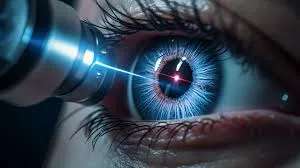If you’re considering laser eye surgery, you’ve probably heard plenty of stories, some reassuring, others downright terrifying. It’s completely natural to feel a mix of excitement and anxiety about taking this life-changing step. The truth is, laser eye surgery has transformed millions of lives worldwide, yet persistent myths continue to hold people back from exploring what could be one of the best decisions they’ll ever make.
Despite decades of successful procedures and continuous technological advancement, misconceptions about laser eye surgery persist. These myths often stem from outdated information, exaggerated stories, or simple misunderstandings about how the procedure actually works. Understanding the facts is crucial for making an informed decision about your vision. That’s why we’re addressing these common myths about laser eye surgery debunked once and for all, so you can move forward with confidence and clarity.
Let’s separate fact from fiction and explore what laser eye surgery really involves, backed by real data and expert insights.
Myth 1: Laser Eye Surgery Is Extremely Painful
The Reality: This is perhaps the most common fear, and thankfully, it’s largely unfounded. Modern laser eye surgery is designed to be as comfortable as possible. Before the procedure begins, your surgeon will apply numbing eye drops that effectively eliminate pain. Most patients describe feeling only slight pressure during the procedure, similar to someone gently pressing on your closed eyelid.
The entire LASIK procedure typically takes just 10-15 minutes for both eyes, and the actual laser treatment lasts only 20-60 seconds per eye. Many patients are surprised to discover that the anticipation was far worse than the actual experience. Post-surgery, you might experience mild discomfort, similar to having an eyelash in your eye, but this typically subsides within 24-48 hours.
What’s particularly reassuring is that over 96% of LASIK patients report being highly satisfied with their results, which speaks volumes about the actual comfort level during and after the procedure. Your surgeon will talk you through every step of the process, ensuring you know exactly what to expect. If you do experience any discomfort during recovery, your eye care team will provide specific guidance and, if necessary, mild pain relief options.
Myth 2: You Can Go Blind from Laser Eye Surgery
The Fear: This myth likely causes more sleepless nights than any other concern about laser eye surgery.
The Truth: There have been no documented cases of blindness directly caused by laser eye surgery in the millions of procedures performed worldwide. This should provide significant peace of mind, especially when you consider that LASIK surgery boasts a success rate of 96-98%, with the vast majority of patients achieving 20/20 vision or better. The laser used in these procedures only affects the cornea (the clear front surface of your eye) and doesn’t penetrate to the deeper structures that could cause blindness.
Modern laser technology includes sophisticated safety features, including eye-tracking systems that automatically pause the laser if your eye moves unexpectedly. Additionally, thorough pre-surgical screening ensures that only suitable candidates undergo the procedure, further minimizing any potential risks.
While serious complications can occur in any surgical procedure, they’re extraordinarily rare with laser eye surgery. Your surgeon will discuss all potential risks during your consultation, but it’s important to put these into perspective alongside the overwhelmingly positive outcomes experienced by the vast majority of patients.
Myth 3: The Results Don’t Last—Your Vision Will Get Worse Again
The Concern: Many people worry that laser eye surgery is just a temporary fix.
The Reality: For the vast majority of patients, laser eye surgery provides permanent vision correction. The reshaping of your cornea during the procedure is permanent, meaning the nearsightedness, farsightedness, or astigmatism that was corrected won’t return.
However, it’s important to understand that laser eye surgery doesn’t prevent natural age-related vision changes. Most people will eventually develop presbyopia (difficulty seeing close objects as we age, typically starting in our 40s), but this would happen whether you had laser surgery or not. Some patients might also experience minor regression over many years, but this is typically minimal and doesn’t usually require glasses for distance vision.
The key is having realistic expectations. Your surgeon will discuss your long-term vision outlook based on your age, prescription, and individual eye characteristics. For most people, laser eye surgery provides decades of clear vision, often eliminating the need for glasses or contact lenses entirely.
Myth 4: You’re Too Old (or Too Young) for Laser Eye Surgery
The Misconception: Many people assume there’s a narrow age window for laser eye surgery.
The Facts: While there are age considerations, the suitable range is broader than many people think. Generally, candidates should be at least 18 years old to ensure their prescription has stabilized. However, there’s no strict upper age limit. What matters more than chronological age is the health of your eyes and the stability of your prescription.
Younger patients (late teens to early twenties) need to demonstrate prescription stability for at least one to two years. This ensures that natural vision changes aren’t still occurring, which could affect surgical outcomes.
Older patients can often be excellent candidates, provided they don’t have age-related eye conditions like cataracts or macular degeneration that would interfere with the procedure or healing process. Many patients in their 50s, 60s, and even 70s have successful laser eye surgery.
The best way to determine if you’re a suitable candidate is through a comprehensive eye examination and consultation with a qualified refractive surgeon, regardless of your age.
Myth 5: Laser Eye Surgery Is Still Experimental or Risky
The Outdated Belief: Some people still think of laser eye surgery as new, unproven technology.
The Current Reality: More than 28 million LASIK procedures have been successfully performed worldwide, making it one of the most thoroughly studied and refined elective procedures available today.
The technology has undergone continuous improvements over the decades. Modern procedures use wavefront-guided lasers that create detailed maps of your eye’s unique characteristics, allowing for incredibly precise, customized treatment. Femtosecond lasers have replaced mechanical microkeratomes in many practices, further improving precision and reducing complications.
The procedure has such a strong track record that refractive surgeons are more than four times more likely to have undergone laser eye surgery themselves compared to the general population. This speaks volumes about the confidence medical professionals have in the procedure.
Myth 6: Everyone Experiences Severe Dry Eyes After Surgery
The Concern: Stories about persistent dry eyes after laser surgery can be particularly worrying.
The Reality: While temporary dry eyes are common after laser eye surgery, severe or permanent dry eye problems are much less frequent than many people believe. Most patients experience some degree of dryness in the first few weeks or months after surgery as their eyes heal, but this typically resolves gradually.
Modern surgical techniques have significantly reduced the incidence and severity of post-surgical dry eyes. Surgeons now have better methods for preserving corneal nerves during the procedure, and there are excellent treatments available for managing temporary dryness.
Your surgeon will likely recommend preservative-free artificial tears during your recovery period. In some cases, additional treatments like punctal plugs (tiny devices that help retain tears) might be suggested. The key is following your post-operative care instructions carefully and communicating with your surgical team about any concerns.
It’s also worth noting that many people who wear contact lenses already experience dry eyes, and laser surgery often eliminates this ongoing issue by removing the need for contacts altogether.
Myth 7: If You Have Astigmatism, You Can’t Have Laser Eye Surgery
The Misunderstanding: Many people with astigmatism believe they’re automatically ruled out for laser eye surgery.
The Truth: Modern laser eye surgery can effectively treat astigmatism alongside nearsightedness and farsightedness. In fact, treating astigmatism is one of the strengths of current laser technology. The sophisticated mapping and laser systems can precisely reshape your cornea to correct the irregular curvature that causes astigmatism.
Astigmatism occurs when your cornea has an oval shape rather than a perfectly round one, causing blurred or distorted vision at all distances. The excimer laser used in procedures like LASIK can selectively remove tissue to create a more spherical corneal shape, effectively correcting the astigmatism.
The amount of astigmatism that can be corrected has increased significantly with technological advances. While severe astigmatism might require alternative approaches or combination treatments, the vast majority of astigmatism cases can be successfully addressed with laser eye surgery.
During your consultation, your surgeon will measure the degree and axis of your astigmatism to determine the best treatment approach for your specific case.
Myth 8: You Can’t Exercise or Play Sports After Laser Eye Surgery
The Worry: Active people often fear that laser eye surgery will limit their lifestyle.
The Actual Guidelines: Most normal activities, including exercise, can be resumed relatively quickly after laser eye surgery. However, there are some temporary precautions to ensure optimal healing.
Generally, you can return to light exercise like walking within a day or two after surgery. More intense workouts can usually be resumed within a week, though you’ll want to avoid getting sweat in your eyes initially. Swimming and water sports typically need to be avoided for about two weeks to prevent infection risk.
For contact sports or activities with high eye injury risk, your surgeon might recommend protective eyewear or a slightly longer waiting period. However, these restrictions are temporary, usually just a few weeks.
Many professional athletes have had laser eye surgery and returned to peak performance. In fact, not having to worry about glasses fogging up, contact lenses drying out, or losing eyewear during activities often enhances athletic performance.
Your surgeon will provide specific guidelines based on your activities and healing progress. The temporary limitations are a small price to pay for the long-term freedom from glasses and contacts during sports and exercise.
Myth 9: Laser Eye Surgery Is Prohibitively Expensive
The Financial Concern: The upfront cost can seem daunting, leading many to assume laser eye surgery is only for the wealthy.
The Economic Reality: When viewed as a long-term investment, laser eye surgery often proves cost-effective compared to a lifetime of glasses and contact lenses. Consider the ongoing expenses: frames, lenses, contact lenses, cleaning solutions, regular eye exams for prescription updates, and replacements for lost or broken eyewear.
Over 10-20 years, these costs can easily exceed the one-time expense of laser eye surgery. Additionally, many practices offer financing options, making the procedure accessible with manageable monthly payments.
There are also intangible benefits that are difficult to quantify financially: the convenience of not searching for glasses, the confidence boost, the ability to participate in activities without vision aids, and the time saved on daily contact lens routines.
Many insurance plans don’t cover laser eye surgery since it’s considered elective, but some offer discounts through vision benefits. Health Savings Accounts (HSAs) and Flexible Spending Accounts (FSAs) can often be used for the procedure, providing tax advantages.
When evaluating cost, consider the total value proposition: the procedure often pays for itself over time while providing decades of improved quality of life.
Myth 10: The Technology Isn’t Advanced Enough Yet, I Should Wait
The Hesitation: Some people perpetually postpone laser eye surgery, thinking better technology is just around the corner.
The Current State: This thinking can lead to years of unnecessary delay. Current laser eye surgery technology is remarkably advanced and continues to deliver excellent results. While improvements are always being made, today’s procedures are already highly refined and effective.
Modern systems include features like wavefront-guided treatments that create a detailed map of your eye’s unique optical characteristics, allowing for incredibly personalized corrections. Femtosecond lasers provide unprecedented precision in creating corneal flaps. Eye-tracking technology compensates for any small movements during the procedure.
The success rates speak for themselves: over 96% of patients achieve 20/20 vision or better, with satisfaction rates exceeding 96%. These are exceptional outcomes by any medical standard.
Waiting for theoretical future improvements means missing out on years of clear vision with current, proven technology. The reality is that laser eye surgery technology has reached a level of sophistication where the benefits of waiting are minimal compared to the advantages of proceeding now.
Your eye care professional can help you understand whether your particular case might benefit from waiting for specific developments, but for most people, current technology provides excellent results.
Making an Informed Decision
Now that we’ve addressed these common myths, you can approach your laser eye surgery decision with accurate information rather than unfounded fears. The reality is that laser eye surgery has helped millions of people worldwide achieve clearer vision and greater freedom from glasses and contact lenses.
Every person’s eyes and vision needs are unique, which is why a thorough consultation with a qualified refractive surgeon is essential. During this consultation, you’ll receive a comprehensive eye examination, discuss your lifestyle and vision goals, and learn about the specific procedures that might be right for you.
Don’t let myths and misconceptions prevent you from exploring what could be a life-changing opportunity. The technology is proven, the results are excellent, and the safety record is outstanding. While no medical procedure is without risk, laser eye surgery has one of the best risk-to-benefit ratios of any elective surgery.
If reading this article has sparked your interest in laser eye surgery, why not take the next step? At The Vision Surgeon, you’ll find a team of experienced professionals who understand that choosing laser eye surgery is a significant decision, one that deserves expert guidance, honest answers, and personalized care.








